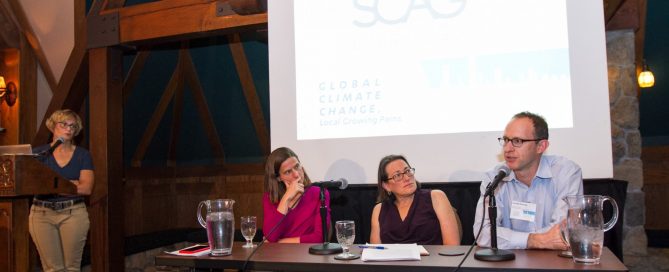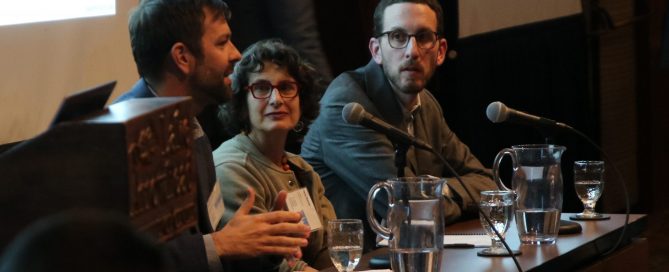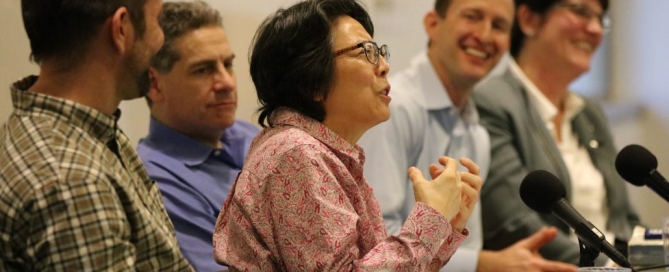News
Lake Arrowhead Symposium: How pricing and technology can improve transportation and climate impacts
By Jordan Fraade
The 27th Annual UCLA Lake Arrowhead Symposium – “Global Climate Change, Local Growing Pains” -tackled the connections and conflicts between sustainability goals and land use policy in California and beyond. Here’s a dispatch from a session on Monday, October 16, and a summary video with the three panelists.
Users of our transportation system are accustomed to flat fees — a single fare per transit ride, a set per-hour rate for street parking, a fixed delivery fee for packages, and so on. […]
Lake Arrowhead Symposium: Building our way to denser, greener, more affordable neighborhoods
By Eve Bachrach
The 27th Annual UCLA Lake Arrowhead Symposium – “Global Climate Change, Local Growing Pains” – tackles the connections and conflicts between sustainability goals and land use policy in California and beyond. Here’s a dispatch from the opening night session and a summary video with the three panelists.
California is not building enough housing, and the denser, more walkable, more environmentally friendly neighborhoods that are being built are not affordable. […]
Recapping our Housing and Activism series: Despite the contentious past, presenting hope for the future
Public Housing and Activism series brought together community members, activists, academics and public officials to discuss the thorny intersection of displacement, environmental justice, and housing policy. The 2016-2017 Housing and Activism series, produced with our partners at the Ziman Center for Real Estate and the Institute on Inequality and Democracy, strove to center stage the people that have lived and are living through the massive federal policy change away from public housing developments. The series started with a look back at the city considered the epicenter for public housing demolition, Chicago, hearing the perspective of former and current residents who witnessed the near wholesale displacement of their community at Cabrini Green. The second installment focused on LA’s own plans for demolition with a conversation on the much debated and awaited Jordan Downs redevelopment. The final event returned to another community that famously fought the loss of its public housing units, Boyle Heights with Pico Aliso, this time addressing the displacement[…]
A Case of Arrested Development – UCLA Housing and Land Use experts on the Road to and From Los Angeles’ Measure S
A complete video recording of the event available on YouTube The merits of an upcoming ballot initiative in the City of LA, Measure S, that would mean big changes for big development projects in the city brought together a panel of UCLA experts in housing and land use. If passed by voters in March 2017, Measure S would impose a temporary moratorium on development projects that require changes to zoning, land use and building height laws in Los Angeles. In addition, the measure would restrict other changes and impose mandatory review procedures to the Los Angeles General Plan, while preventing project applicants from conducting their own Environmental Impact Reports (EIR). “If you’re a developer and you want to do some affordable housing … it would be informally discouraged in wealthier areas,” said Joan Ling, a longtime lecturer in the UCLA Luskin Department of Urban Planning. “There’s a lot of talk about reforming land use laws in L.A., but there’s very[…]
2016 Arrowhead Symposium: Investing in Sustainable Mobility
Every year, urban planners, academics, public officials, and transportation enthusiasts gather in the mountains near San Bernardino for 3 days of thoughtful, frank discussions on the connections between transportation, land use, and the environment. This year’s Lake Arrowhead Symposium was no different, with all the sessions revolving around the theme of “Paying It Forward: Investing in Sustainable Mobility.” Panelists and attendees came from all over the country to discuss funding innovative transportation programs, coping with fiscal uncertainty, and planning for future innovations like Autonomous Vehicles.This was the 26th annual installment of the Arrowhead Symposium, which is always an intimate, invite-only gathering, and we’ve put together 4 stories to share some of the highlights with you.1. Adding Capacity Without Adding ConcreteThe era of major highway construction is over, and there’s still traffic everywhere. Are there other ways to help cut down on congestion?2. Funding Transportation Through Cap-and-TradeOne of California’s most innovative transit-funding programs is also one of its most unpredictable. How can we plan for the future?3. How[…]
Getting Ready For the Rise of Autonomous Vehicles
Autonomous vehicles (AV) are coming, and they are coming faster than we imagined (possibly within the next 5-10 years), but are we ready? AVs have the potential to transform the way people travel, but their impacts on congestion, greenhouse-gas emissions, and travel patterns will largely depend on planning and policy choices. A reoccurring question of concern in this Monday afternoon session was whether a world of driverless cars would be considered heaven or hell in the realm of transportation. Randy Iwasaki, Executive Director of Contra Costa County Transportation Authority (CCTA), showcased the progress CCTA has made with AVs. Under his leadership, CCTA has founded a large connected vehicle (CV) and AV test facility located in Concord, CA (GoMentum Station Program). Among other things, CCTA is exploring how shared AVs like autonomous 12-passenger vans that serve as shuttles to BART and other destinations could complement mass transit to overcome first mile-last mile challenges. Following Iwasaki’s presentation, Prof. Joan Walker, co-director of the[…]
How Will High-Speed Rail Change California?
California’s High-Speed Rail system isn’t just the biggest transportation project happening in the state right now, it’s the biggest public-works project ever in the history of California. Monday night’s panel, moderated by UCLA Prof. Emeritus Martin Wachs, convened experts to discuss what Californians can expect from this huge undertaking in the years ahead. Wachs began the panel by stressing just how much of a work in progress High Speed Rail is. The overall estimated price tag is $64 billion, and $40 billion of that amount is still uncommitted. In order to save money, the system is being built from the middle out, meaning it won’t serve either of the state’s two main cities for some time. Above all, Wachs noted, “the rules about expending the funds that we have are forcing, in the short run, decisions which are very complex and which are shaping the project in the long run.”As an example of this, Wachs pointed to the legislative mandate[…]
Funding Transportation Through Cap-and-Trade
Sunday night’s panel, “Cap and Trade and the Implications of Stop-And-Go Transportation Funding,” provided a crash course on one of the state’s most innovative funding mechanisms for public transit. Ever since California passed AB32 in 2006, the state’s greenhouse-gas reduction mandates have been some of the strictest in the nation, setting the goal of reducing GHG levels to 1990 levels by 2020, and then reducing them again by 80% by the year 2050. The state-run Cap and Trade program has been a highly publicized part of this process, and because a certain portion of C&T funding is set aside to fund low-carbon transportation, a panel of environmental experts got together to discuss the program’s successes and failures.JR DeShazo of UCLA’s Luskin Center for Innovation explained the basic structure of the state’s Cap and Trade program: A business needs a permit to emit a ton of carbon, and there is an overall statewide cap on the number of permits that can[…]
Adding Capacity Without Adding Concrete
Traffic congestion is a condition that Los Angeles residents know all too well. But how do we fix traffic? The speakers from Sunday afternoon’s panel offered sustainable and cost-effective solutions, including pricing, policy, and technological solutions, to add capacity to our roads without adding more concrete. The highlight of the session was the study on California’s Road User Charge Pilot Program, discussed by UCLA Professor Emeritus Martin Wachs. Infrastructure is aging, while the funding to maintain infrastructure is shrinking. Revenue from gas tax has declined due to the increasing fuel-efficiency of cars. Road-user charges offer a new revenue source for the state to fund infrastructure improvements. The California Road User Charge program replaces the current gas tax, in which drivers pay a tax on each gallon of fuel they purchase, with a road-user charge based on Vehicle Miles Traveled (VMT). There are approximately 5000 participating vehicles statewide with a 9-month long demonstration. Interestingly, those who have the most efficient cars[…]
Obama Administration Tackles Housing Affordability, Cites Lewis Center Scholars
In releasing a Housing Development Toolkit earlier this week, the U.S. Department of Housing and Urban Development amplified a growing chorus of voices calling for reform to regulations that limit housing production. The report states, “The increasing severity of under-supplied housing markets is jeopardizing housing affordability for working families, exacerbating income inequality by reducing workers’ access to higher-wage labor markets, and stifling GDP growth by driving labor migration away from the most productive regions.” In its opening discussion of the prevalence of local barriers to housing development, the report draws on UCLA Lewis Center scholars several times. First, the report cites PhD alumnus Greg Morrow’s work in a discussion of Los Angeles that is a case study for what local cities should not do. Morrow showed that in 1960, Los Angeles was zoned for 10 million people; after decades of increasingly stringent housing regulations, it is now zoned for only 4.3 million, a figure only slightly higher than the city’s[…]



